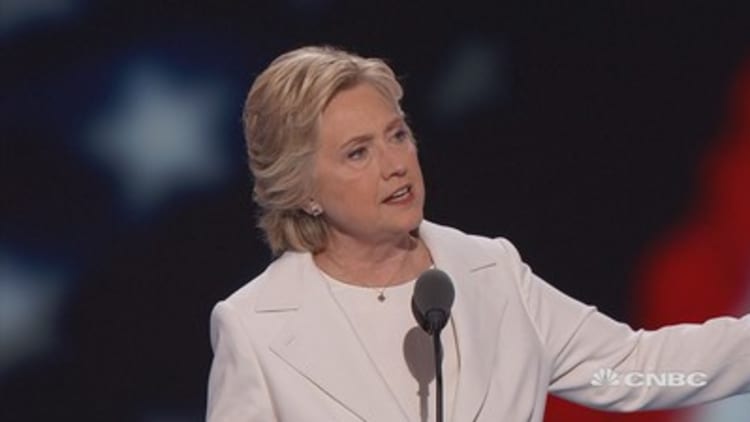
Hillary Clinton took aim at the rich Thursday night, saying she would fund new government programs with money from the privileged few.
"Wall Street, corporations and the super-rich are going to start paying their fair share of taxes," she said while delivering a speech at the Democratic National Convention in Philadelphia.
"Not because we resent success. Because when more than 90 percent of [income] gains have gone to the top 1 percent, that's where the money is. And we are going to follow the money," she said.
Clinton is broadly right about inequality. The rich are increasingly where the money can be found. But her numbers referring to the recent income gains of the rich are wrong — by a wide margin.
Clinton's statement that 90 percent of said gains have gone to the top 1 percent is certainly attention-grabbing. Her numbers even outdo those from the king of wealth redistribution, Bernie Sanders, who said in his convention speech that the top 1 percent have earned 85 percent of all new income.
Yet the most recent and reliable studies of income gains suggest that the 1 percent are gaining closer to half of all income gains, not 90 percent. And their share of those gains has been falling in recent years, not rising.
The most respected and thorough analysis on this subject comes from Emmanuel Saez at the University of California, Berkeley. In his analysis titled "Striking it Richer," which is based off IRS and other macroeconomic data, Saez found that in the first six years of recovery from the recession (between 2009 and 2015), the top 1 percent accounted for 52 percent of the nation's income gains.
There were a few years in which the group captured a 90 percent share of income gains. That was between 2009 and 2012, when the wealthy received a one-time income burst from selling assets to avoid tax hikes in 2013.
But as the recovery has progressed, the 99 percenters have made up some ground. As gains have moderated at the top, they've gained steam at the bottom. As Saez explains, the broader population in 2014 and 2015 saw the strongest income gains in years. As a result, that 90 percent number has fallen to 52 percent.
"2014 and 2015 are the first two years where bottom 99 percent incomes have finally started to grow significantly," he said.
None of this is to say that inequality isn't a problem, or that an economy that gives half of all earnings to the top 1 percent is acceptable. And Republican nominee Donald Trump has had more than his share of financial fishiness, from questions about his net worth — which experts say is less than half of his estimate — to his claim that he would raise taxes on the wealthy — even though his tax plan gives the 1 percent an average tax cut of $275,000 a year.
Yet if Clinton aims to be the candidate of credibility, she should update her numbers and say "half" rather than 90 percent. It would still make the point — with the benefit of being accurate.


